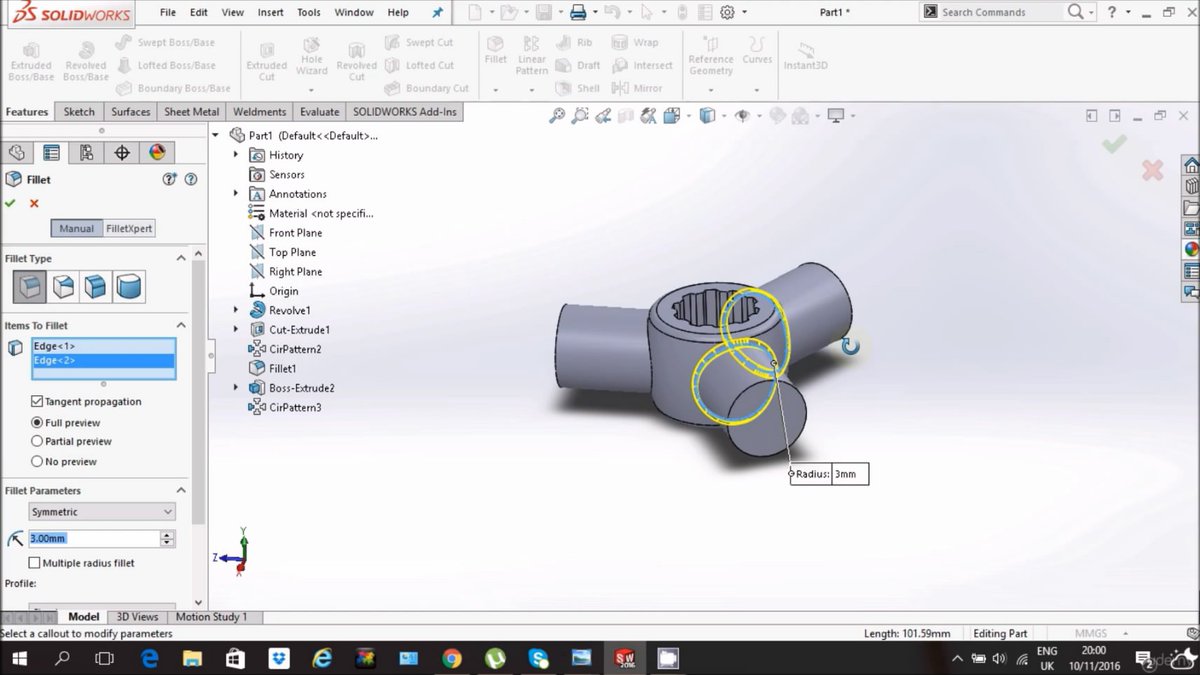Sunday, October 8, 2017
Apple open-sourced the kernel of iOS and macOS for ARM processors
Russia Provides New Internet Connection to North Korea
Apple is looking into reports of iPhone 8 batteries swelling
AIM will shut down after 20 years
Get ready for home internet prices to double
Google gets go-ahead to restore cell phone service in Puerto Rico with its balloons
The series that reigns supreme
Friday, October 6, 2017
Enterprises must think about how augmented reality, artificial intelligence and robotics may impact the hopes and expectations of Generation Z
Understanding the emerging world of 'fake everything' is vital
facebook faces stiff competition on multiple fronts
lean tips about mobile device repair
Open source and Linux become new security headache
Saturday, September 23, 2017
how use solidworks create Propeller | video lesson practice exercises
http://www.ikeye100.com/solidworkstutorilas/81/
Today in this Basic Tutorial of SolidWorks we will create a Propeller to demonstrate the utilization of part modeling feature .
buy solidworks cheap solidworks



SOLIDWORKS 2017 Premium is powerful solid modeling computer-aided design (CAD) and computer-aided engineering (CAE) program especially for creating 2D or 3D models. It has all the latest designing tools and features that help the designers in designing single components, incredibly complex equipment, or even entire facilities and turn ideas into higher quality products. There are new powerful modeling tools are there in this version. These helps the designers to design faster, easier modeling with fewer picks and clicks.
You can buy solidworks program at low price and other solidworks tutorials.Everything you need to learn what's new, including tech tips, demos, and upcoming product webinars.
learn solidworks feature flex by video practice exercise Model a professional fins
http://www.ikeye100.com/solidworkstutorilas/80/
In this video we are going to elaborate Flex feature capabilities of SolidWorks.
Flex features deform complex models in an intuitive manner.You can create four types of flexes:Bending,Twisting,Tapering,Stretching.
The flex feature calculates the extents of the part using a bounding box. The trim planes are then initially located at the extents of the bodies, perpendicular to the blue Z-axis of the triad .The flex feature affects the region between the trim planes only.The center of the flex feature occurs around the center of the triad location.To manipulate the extent and location of the flex feature, re-position the triad and trim planes. To reset all PropertyManager values to the state they were in upon opening the flex feature, right-click in the graphics area and select Reset flex.
buy solidworks cheap solidworks



SOLIDWORKS 2017 Premium is powerful solid modeling computer-aided design (CAD) and computer-aided engineering (CAE) program especially for creating 2D or 3D models. It has all the latest designing tools and features that help the designers in designing single components, incredibly complex equipment, or even entire facilities and turn ideas into higher quality products. There are new powerful modeling tools are there in this version. These helps the designers to design faster, easier modeling with fewer picks and clicks.
You can buy solidworks program at low price and other solidworks tutorials.Everything you need to learn what's new, including tech tips, demos, and upcoming product webinars.
solidworks using surfaces tool,circle and extrude boss/base feature create Hand Bracelet | video lesson practice exercises
http://www.ikeye100.com/solidworkstutorilas/82/
This video covers the SolidWorks lots of feature. i will create a Hand Bracelet.
The details of how to use this urfaces tool ,circle and extrude boss/base feature
buy solidworks cheap solidworks



SOLIDWORKS 2017 Premium is powerful solid modeling computer-aided design (CAD) and computer-aided engineering (CAE) program especially for creating 2D or 3D models. It has all the latest designing tools and features that help the designers in designing single components, incredibly complex equipment, or even entire facilities and turn ideas into higher quality products. There are new powerful modeling tools are there in this version. These helps the designers to design faster, easier modeling with fewer picks and clicks.
You can buy solidworks program at low price and other solidworks tutorials.Everything you need to learn what's new, including tech tips, demos, and upcoming product webinars.
how to make a Necklace in solidworks | video tutorial practice exercises
http://www.ikeye100.com/solidworkstutorilas/83/
in this tutorial video i will show you how to sketch chain in solidworks.
buy solidworks cheap solidworks




SOLIDWORKS 2017 Premium is powerful solid modeling computer-aided design (CAD) and computer-aided engineering (CAE) program especially for creating 2D or 3D models. It has all the latest designing tools and features that help the designers in designing single components, incredibly complex equipment, or even entire facilities and turn ideas into higher quality products. There are new powerful modeling tools are there in this version. These helps the designers to design faster, easier modeling with fewer picks and clicks.
You can buy solidworks program at low price and other solidworks tutorials.Everything you need to learn what's new, including tech tips, demos, and upcoming product webinars.
how to make Electric Cable in solidworks | video tutorial practice exercises
http://www.ikeye100.com/solidworkstutorilas/84/
in this tutorial video i will show you how to Electric Cable in solidworks.wire is a very important in design
buy solidworks cheap solidworks




SOLIDWORKS 2017 Premium is powerful solid modeling computer-aided design (CAD) and computer-aided engineering (CAE) program especially for creating 2D or 3D models. It has all the latest designing tools and features that help the designers in designing single components, incredibly complex equipment, or even entire facilities and turn ideas into higher quality products. There are new powerful modeling tools are there in this version. These helps the designers to design faster, easier modeling with fewer picks and clicks.
You can buy solidworks program at low price and other solidworks tutorials.Everything you need to learn what's new, including tech tips, demos, and upcoming product webinars.
how to make Truck Steering Wheel in solidworks | video tutorial practice exercises
http://www.ikeye100.com/solidworkstutorilas/85/
SolidWorks Tutorial Wheel And Axle Assembly
Watch Complete Video How to make Truck Steering Wheel
buy solidworks cheap solidworks




SOLIDWORKS 2017 Premium is powerful solid modeling computer-aided design (CAD) and computer-aided engineering (CAE) program especially for creating 2D or 3D models. It has all the latest designing tools and features that help the designers in designing single components, incredibly complex equipment, or even entire facilities and turn ideas into higher quality products. There are new powerful modeling tools are there in this version. These helps the designers to design faster, easier modeling with fewer picks and clicks.
You can buy solidworks program at low price and other solidworks tutorials.Everything you need to learn what's new, including tech tips, demos, and upcoming product webinars.
how to make Engine Air Filter in solidworks | video tutorial practice exercises
http://www.ikeye100.com/solidworkstutorilas/86/
This video will show you how to design air filter of engine...This may help you in design field
buy solidworks cheap solidworks




SOLIDWORKS 2017 Premium is powerful solid modeling computer-aided design (CAD) and computer-aided engineering (CAE) program especially for creating 2D or 3D models. It has all the latest designing tools and features that help the designers in designing single components, incredibly complex equipment, or even entire facilities and turn ideas into higher quality products. There are new powerful modeling tools are there in this version. These helps the designers to design faster, easier modeling with fewer picks and clicks.
You can buy solidworks program at low price and other solidworks tutorials.Everything you need to learn what's new, including tech tips, demos, and upcoming product webinars.
learn solidworks sketch Spider of a tripod joint video lesson practice exercises
http://www.ikeye100.com/solidworkstutorilas/79/
It is the new solidworks traing video .i will make a Spider of a tripod joint in solidworks with the help of sketch and feature tools.
buy solidworks cheap solidworks



SOLIDWORKS 2017 Premium is powerful solid modeling computer-aided design (CAD) and computer-aided engineering (CAE) program especially for creating 2D or 3D models. It has all the latest designing tools and features that help the designers in designing single components, incredibly complex equipment, or even entire facilities and turn ideas into higher quality products. There are new powerful modeling tools are there in this version. These helps the designers to design faster, easier modeling with fewer picks and clicks.
You can buy solidworks program at low price and other solidworks tutorials.Everything you need to learn what's new, including tech tips, demos, and upcoming product webinars.
solidworks video practice exercises how model Motorbikes brake rotor
http://www.ikeye100.com/solidworkstutorilas/78/
In this video ,we will show you how step by step model Motorbikes brake rotor.using those tools.
buy solidworks cheap solidworks


SOLIDWORKS 2017 Premium is powerful solid modeling computer-aided design (CAD) and computer-aided engineering (CAE) program especially for creating 2D or 3D models. It has all the latest designing tools and features that help the designers in designing single components, incredibly complex equipment, or even entire facilities and turn ideas into higher quality products. There are new powerful modeling tools are there in this version. These helps the designers to design faster, easier modeling with fewer picks and clicks.
You can buy solidworks program at low price and other solidworks tutorials.Everything you need to learn what's new, including tech tips, demos, and upcoming product webinars.


